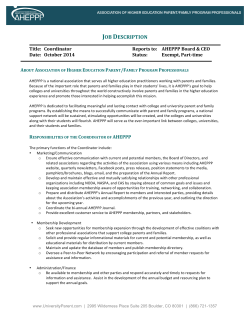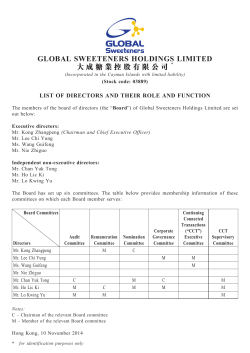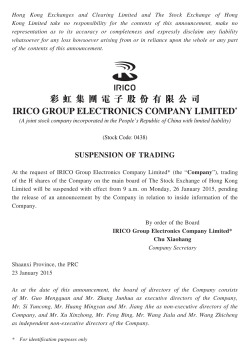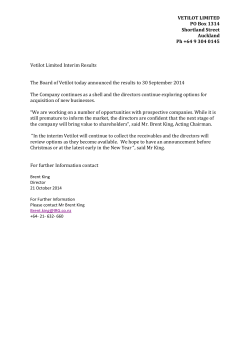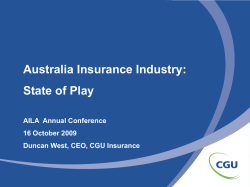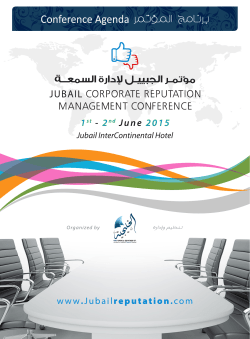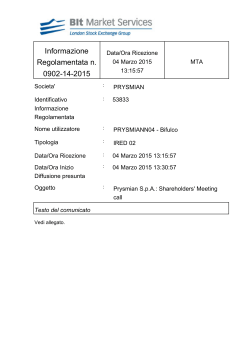
What Directors Can Do When So Much is At Stake
Webinar September 12, 2012 What Directors Can Do When So Much is At Stake 1 Introduction by Jim Kristie, Editor & Associate Publisher, Directors & Boards } Time for questions (enter them from your computer) during and after the presentation } 60 Minutes } Presentation and supporting material will be emailed to all participants after the webinar } 2 Bob Holland, Director, Lexmark Corporation and Carver Bank Sarah Stewart, Managing Director, Boyden Davia B. Temin, President and CEO, Temin and Company 3 } The difference, averaged over time, between market cap and liquidation value of assets (Fombrun) } The totality of everything a company is, does, and says, as well as what others say and think (Temin) 4 5 6 Loss of customers/revenue } Leadership changes } Lower productivity/poor employee morale } Diminishing value/sinking stock price } Unhappy shareholders = lawsuits } Investigations + new regulations } Employee departures } Inability to attract capital and talent } 7 The buck stops with the Board ◦ Board’s role is to protect value for shareholders ◦ Reputation is an intangible asset with tangible, valuable byproducts ◦ Financial/accounting scandals are always viewed as a failure of governance ◦ The Board’s response to all other reputation damaging events is highly scrutinized by analysts, reported in the press, and discussed in social media 8 } } Eisner Amper asked directors to rank their biggest concerns (excluding financial risk) Top Five Answers ◦ ◦ ◦ ◦ ◦ Reputational risk (66%) Regulatory compliance (59%) IT risk (54%) CEO succession planning (53%) Crisis management (47%) 9 } Within the category of reputational risk, directors worry most about: ◦ Product quality/customer satisfaction (30%) ◦ Integrity/fraud/ethics (24%) ◦ Public perception (16%) 10 } Director reputations are tarnished, too, and in the aftermath of scandal, they increasingly face: ◦ Pressure to step off other Boards ◦ Being passed over for other Board seats ◦ Disillusionment regarding Board service ◦ Possible personal liability 11 1. Put reputational risk on the board agenda 2. Let the Board’s scrutiny be known 3. Establish best practices to identify, prioritize, and address reputational issues 4. Stress test business processes and management 5. Review how management monitors reputation and review results 2x per year 6. Monitor employee and client engagement surveys. Look for red flags 12 7. Review unedited traditional and social media, quarterly 8. Require preparation of a full list of reputational risks, both predictable and black swan 9. Review crisis plan to deal with those risks 10. Create a board crisis plan 11. Engage in crisis simulation at the board level 12. Assure that company’s proactive mission statement is taken seriously across the organization. 13. Make the board’s expectations around integrity, risk, quality, strategy and excellence clear 13 14. Enforce those expectations by holding one another and management accountable and by taking fast, corrective measures when needed. 15. In crisis, be strong, visible, proactive, and assure management is focuses on integrity and solutions 16. In crisis, limit liability but not humanity 17. Focus on rebuilding stakeholder trust after crisis 18. Assure company becomes part of a solution 19. Assure company grows more resilient and responsible 20. Make sure to stand in for the public, as well as shareholders in a crisis, mandating the company “do the right thing” under pressure 14 } Right mix of skills and experience ◦ First-hand knowledge of the industry ◦ Experience relevant to strategy/challenges ◦ Required and/or valuable functional expertise ◦ Expansive views from outside the company/ industry ◦ Differing perspectives 15 } Strong evaluation skills coupled with currency ◦ Understand systems and controls ◦ Can spot red flags in financial/operating reports ◦ Can interpret data on non-financial performance measurements ◦ Current with technology and evolving business landscape (i.e., new media) 16 } Character/temperament ◦ Brings a healthy skepticism ◦ Courageous; willing to act ◦ Understands the power of language and communication ◦ Steady and calm in the face of adversity ◦ Stays focused and in the game 17 } Underscores the need for diversity of all kinds ◦ Better chance that someone will recognize a potential crisis ◦ Differing viewpoints that lead to deeper discussions and better decisions ◦ More likely to have had personal experience with any issue 18 Forensic accounting } Chief Risk Officers } Government/Public Service – i.e., Louis Freeh } Turnaround experts } Highly respected CEOs – i.e., Jack Krol } Military Leaders } 19 • • • In addition to changes on the management team, scandals often drive new board composition Many companies add directors after a crisis to burnish the company’s reputation What those directors bring depends on individual circumstances 20 The Board has a major influence on corporate reputation } Elevate reputation on the Board’s Agenda } Recognize that, sooner or later, there will be a crisis } The Board’s response can be more important than the event itself } Get a crisis plan in place } 21 Sarah Stewart Managing Director-Board Services Boyden 1000 Gamma Drive, Suite 600 Pittsburgh, PA 15238 412-756-1000 Davia Temin President & CEO Temin and Company 750 Seventh Avenue, 26th Floor New York, NY 10022 212-588-8788 22
© Copyright 2025


